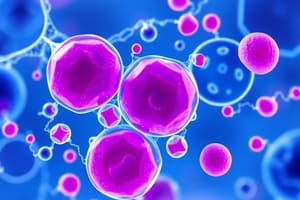Podcast
Questions and Answers
What is the function of organelles in a cell?
What is the function of organelles in a cell?
- Maintaining homeostasis
- Transporting molecules
- Communication via chemical signals
- All of the above (correct)
Which of the following is NOT a characteristic of cell membranes?
Which of the following is NOT a characteristic of cell membranes?
- Interact with the external environment
- Separate the inside from outside
- Allow cells to move freely without any boundaries (correct)
- Maintain cell identity
What is the primary role of cells in living systems?
What is the primary role of cells in living systems?
- Metabolism
- Waste removal
- Maintaining homeostasis (correct)
- Reproduction
Which term refers to the compartments within a cell separated by membranes?
Which term refers to the compartments within a cell separated by membranes?
What happens when any one of the cellular processes like metabolism or waste removal malfunctions?
What happens when any one of the cellular processes like metabolism or waste removal malfunctions?
Which structure allows cells to interact with the external environment while maintaining their identity?
Which structure allows cells to interact with the external environment while maintaining their identity?
What is the primary role of the semipermeable cell membrane?
What is the primary role of the semipermeable cell membrane?
Which organelle is responsible for holding genetic information in the form of DNA?
Which organelle is responsible for holding genetic information in the form of DNA?
What is the main function of the Golgi apparatus?
What is the main function of the Golgi apparatus?
Which organelle is known as the 'powerhouse' of the cell?
Which organelle is known as the 'powerhouse' of the cell?
During which phase of the cell cycle does DNA synthesis occur?
During which phase of the cell cycle does DNA synthesis occur?
What is one of the roles of endoplasmic reticulum in the cell?
What is one of the roles of endoplasmic reticulum in the cell?
Flashcards are hidden until you start studying
Study Notes
Exploring Life's Building Blocks: Understanding Cells and Their Components
At the heart of all living creatures lies a fundamental unit that drives their existence – the cell. Over centuries, biologists have uncovered the intricate details of this microscopic marvel, revealing its essential components and functions. Let's delve into these aspects more closely.
Cell Structure
Cells come in various shapes like spheres, rods, or discs depending upon their origins and functions. Regardless of form, each contains distinct regions, known as compartments, separated by specific membranes. These membranous boundaries enclose structures called organelles, which help cells carry out specialized tasks efficiently.
Cell Function
A primary role of cells is maintaining homeostasis within living systems, ensuring they can adapt and respond to internal and external stimuli. To achieve this goal, cells engage in diverse activities such as metabolism, transporting molecules, communication via chemical signals, reproduction, and waste removal. Indeed, when any one of these processes malfunctions, health problems arise.
Cell Membrane
The boundary that separates the inside from outside, allowing cells to maintain their identity while still interacting with the world around them, is the cell membrane or plasma membrane. This semipermeable barrier consists primarily of phospholipids, proteins, and carbohydrates, playing crucial roles in regulating what enters and leaves the cell, controlling shape, anchoring certain organelles, and serving as a platform for receptors involved in intercellular signaling.
Cell Organelles
Organized compartments present within cells perform unique duties. Some major ones include:
- Nucleus: Holds genetic information in the form of DNA and directs expression and synthesis of RNA. It also coordinates protein production and cell division.
- Mitochondria: The powerhouse of the cell, generating ATP – energy currency required for most cellular reactions. Mitochondria also participate in programmed cell death (apoptosis) under certain conditions.
- Endoplasmic reticulum (ER): An extensive network of flattened sacs and tubules involved in protein folding, modification, and transportation to other locations in the cell or extracellular milieu. ER may also serve as a site for manufacturing lipids, steroids, hormones, and detoxification.
- Golgi apparatus: Densely packed stacks of flattened membrane sacs responsible for modifying, sorting, and packaging newly produced proteins and lipids before sending them to different destinations within or outside the cell.
Cell Cycle
Central to growth and proliferation amongst living things, the orderly progression through stages during which genetic material duplicates and divides equally between two daughter cells constitutes the cell cycle. Interactions between regulatory proteins ensure proper timing, coordination, and completion of the four main phases: G1 phase (DNA synthesis preparation), S phase (synthesis of new DNA), G2 phase (preparation for mitosis), and Mitosis itself (separating chromosomes into two separate nuclei).
In summary, understanding cells and their constituents provides us with knowledge of how life works at its most basic level. As we continue advancing our comprehension of these building blocks, it becomes apparent why science appreciates their importance in elucidating the mysteries surrounding human physiology, wellbeing, and disease states alike.
Studying That Suits You
Use AI to generate personalized quizzes and flashcards to suit your learning preferences.




